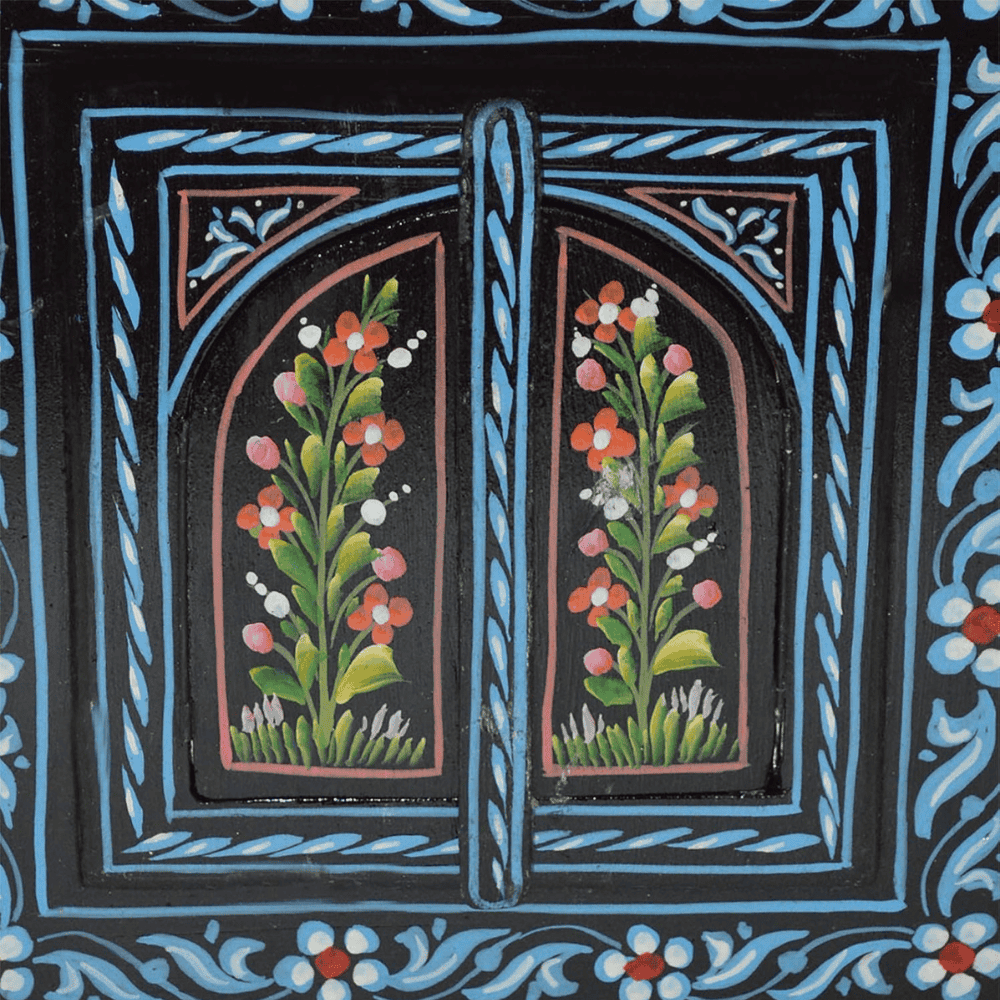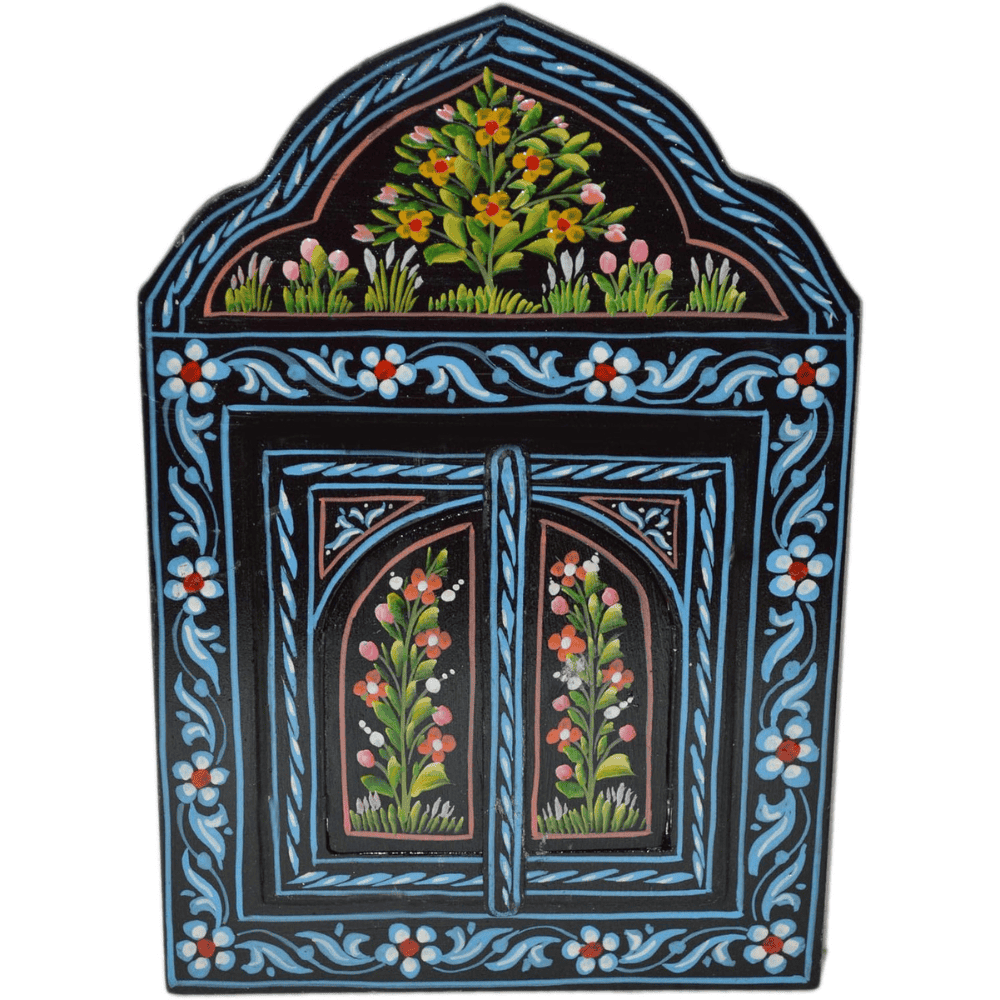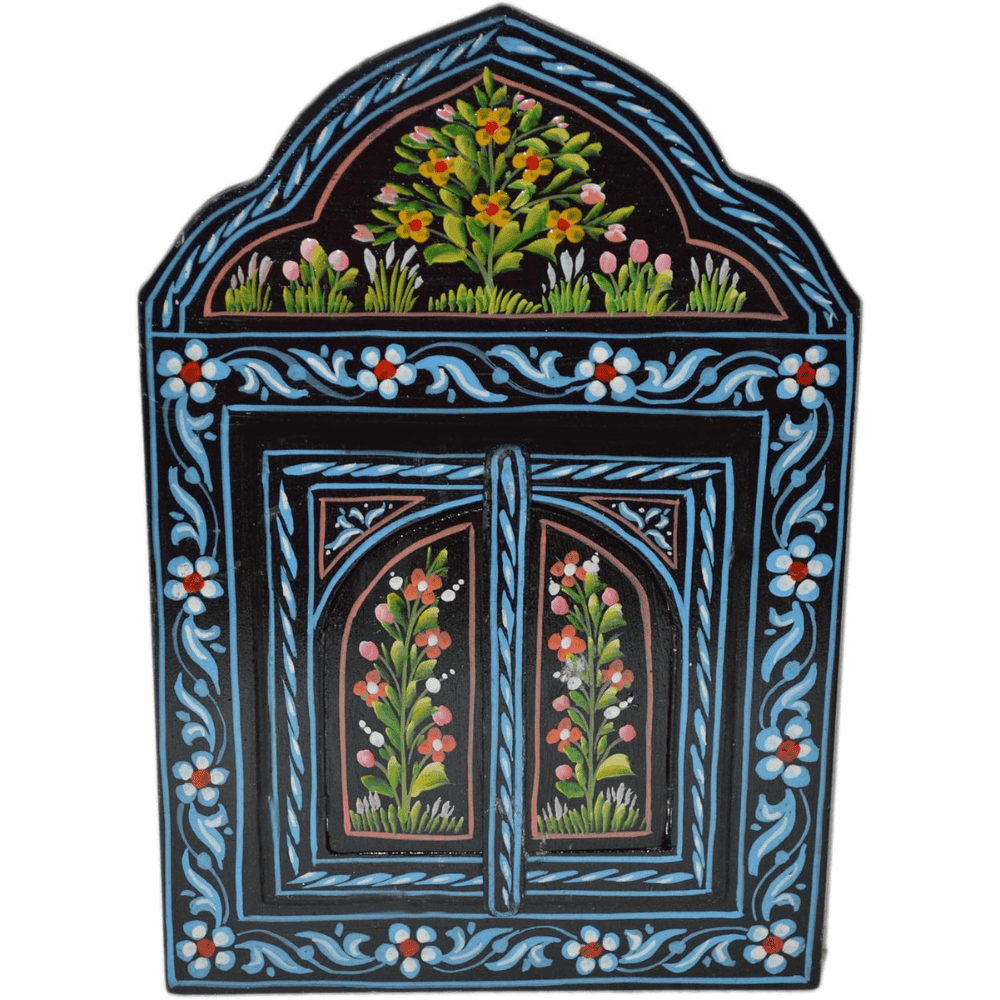What defines the craftsmanship of this Moroccan wall mirror?
This mirror originates from Marrakech workshops where skilled artisans shape the wood frame and apply hand-painted arabesque motifs. Feature: the frame is constructed from a wood foundation with a glass insert and finished by hand. Advantage: hand-finishing allows finer control over pattern density, paint layering, and surface texture compared with machine production. Benefit: the result is a mirror that carries subtle variations in brushwork and tone, giving a tactile, lived-in character that mass-made pieces lack. The craftsmanship also involves careful joining of the glass to the wooden frame and a sealing process that protects paint edges while keeping the finish breathable. The doors are fitted with small hinges and alignments checked by hand, which ensures they open and close with a simple, quiet motion. The combination of these manual steps produces a reliable decorative object that reads as both functional mirror and small-scale art object.
- Hand-built wood foundation with glass insert
- Hand-painted arabesque detailing
- Hand-fitted doors and simple hinge mechanism
How does the arched shape influence the mirror’s visual presence?
The arched silhouette follows a long architectural tradition, echoing Moorish doorways and interior arches. Feature: the arched top and straight sides create a balanced geometric profile. Advantage: this profile directs sightlines upward, producing a perception of additional vertical space on a wall and softening angular interiors. Benefit: small rooms gain a sense of height without the need for structural change, and the mirror serves as a focal element without dominating the wall. The arch also frames reflections differently than a rectangle, focusing light toward the center and creating a soft halo effect across the glass. That concentrated reflection works well near windows or lamps, subtly redistributing light. The shape complements vertical décor arrangements and integrates with shelving, sconces, or textile hangings, facilitating layered compositions that feel intentional rather than accidental.
- Arched profile enhances vertical perception
- Softens angular interiors and focalizes light
- Works well with vertical arrangements and wall art
What makes the hand-painted arabesque decoration significant?
Arabesque motifs are geometric and floral repetitions that carry a decorative rhythm across the frame. Feature: hand-paint application in black over the wooden foundation creates crisp pattern contrast. Advantage: manual painting yields controlled line weight and subtle irregularities that add depth and texture; these small variations make each piece visually unique. Benefit: the viewer experiences a richer surface under changing light, where fine brush marks and slight pigment density shifts create a dynamic look. The arabesque layout balances negative space and pattern, preventing visual overload while still offering ornate detail. This approach keeps the reflective area clearly visible while framing it with purposeful pattern, so the mirror reads as both functional glass and crafted artwork. The finish resists appearing flat because brush layering produces faint ridges and tonal shifts that catch the eye.
- Traditional arabesque patterning hand-applied
- Visual texture from brushwork and pigment layering
- Pattern frames reflection without obstructing it
Why is the combination of wood and glass chosen for this piece?
Wood and glass together address structure, warmth, and optical clarity. Feature: a solid wood foundation supports the glass mirror and the hinged doors. Advantage: wood provides a lightweight but stable core that accepts paint well, and glass offers a crisp reflective surface that resists distortion. Benefit: the pairing yields a durable object that still feels approachable; wood contributes tactile warmth to contrast the coolness of glass while glass brightens a room by reflecting light. The wood frame also mitigates vibration and absorbs minor impacts, reducing risk to the glass during handling. On a practical level, the wood foundation allows the hand-paint surface to take pigments in a way that metal or plastic would not, preserving the character of the arabesque work. This materials strategy balances longevity with artisan expression.
- Wood for structure and paintability
- Glass for clear, undistorted reflection
- Material pairing improves durability and aesthetic warmth
How does the handcrafted finish affect authenticity and variation?
Handcrafting produces slight differences between individual mirrors, and that variation signifies authenticity. Feature: each mirror receives paint, sealant, and minor adjustments by hand rather than machine. Advantage: natural variation in brushstroke, pigment thickness, and minor surface texture means no two mirrors match exactly; small asymmetries and color shifts occur organically. Benefit: the piece reads as unique and human-made, which adds character to an interior setting where uniform factory pieces might feel sterile. Those differences also allow natural aging and patina to develop in a pleasing way; tiny paint hairlines or surface irregularities blend with everyday use rather than appearing as damage. For buyers seeking a handcrafted presence, these qualities function as evidence of genuine artisan labor rather than production variance to be hidden.
- Subtle color and brushwork differences expected
- Hand-finished surfaces develop natural patina
- Variation indicates artisan-made authenticity
What practical installation and size details should be noted?
Installation is simple and requires minimal hardware. Feature: the mirror measures approximately 13.5 inches high by 9 inches wide and mounts with a single small nail or hook. Advantage: the compact footprint makes this mirror suitable for tight spaces such as entryway nooks, above small consoles, or as part of a gallery wall; the light weight reduces the need for heavy anchors. Benefit: mounting is fast and low-effort, allowing placement flexibility and experimentation with composition on the wall. The small size also limits the risk of damage during handling and makes two-piece configurations feasible without overwhelming a wall. Practical considerations include locating a wall stud for maximum security if the mirror will be placed in a high-traffic area, and ensuring the chosen hanging point keeps the reflective center at an appropriate eye height for the intended use.
- Dimensions: ~13.5″ x 9″
- Mounts with a single small nail or hook
- Compact size suitable for tight or layered arrangements
How does the black finish alter the mirror’s visual impact?
Black paint provides a strong, defining edge to the arabesque frame while maintaining neutrality with other décor. Feature: a matte or low-sheen black finish wraps the frame and painted details. Advantage: black creates contrast against light walls and complements darker backgrounds without competing with patterned textiles or other colored objects. Benefit: the mirror becomes an anchoring element that supports layered interior schemes; the strong outline helps the arched shape read clearly even at a distance. In practical terms, black hides minor handling marks better than lighter finishes, and it pairs well with brass, copper, and natural wood tones. Opting for black keeps the visual emphasis on pattern and shape rather than color, supporting versatile placement across varied palettes.
- Black defines frame contours and highlights pattern
- Neutral pairing with many interior palettes
- Practical finish that conceals minor marks
What cultural and historical context does this mirror hold?
The design language draws from Moroccan and broader North African decorative traditions. Feature: the arabesque geometry and arched silhouette reference centuries of regional architecture and surface decoration. Advantage: this lineage gives the mirror a layered narrative; it operates not only as a reflective tool but as a small artifact that carries specific design codes. Benefit: placing this mirror in a contemporary interior introduces a discreet cultural accent that suggests craft history without theatrical stylization. The presence of such a piece can shift a room’s tone toward warmth and depth and can serve as a conversation seed about material culture, artisan practice, and regional design choices. For interiors aiming to incorporate meaningful objects rather than ephemeral trends, that context adds measurable cultural value.
- Design references Moroccan architectural and decorative codes
- Functions as cultural accent with historical lineage
- Introduces craft-based narrative into modern interiors
How will this mirror adapt to different interior styles?
The mirror’s scale, shape, and finish create broad compatibility across interior schemes. Feature: an arched black frame with hand-painted arabesque motifs. Advantage: the restrained color and classic silhouette enable pairing with bohemian, Scandinavian, industrial, or traditional décors; the artisan surface prevents it from appearing overly precious in casual settings. Benefit: the mirror acts as a bridging piece that can unify mixed furnishings, from raw wood tables to modern metal lighting. In practice, the mirror pairs successfully with layered textiles, brass accents, and houseplants; it also supports minimalist settings by offering a single detailed element that anchors the room without adding visual clutter. The adaptability makes it practical for staged rooms, rental properties, or personal spaces where flexibility is desirable.
- Pairs with eclectic and minimal interiors
- Acts as a bridging accent among varied materials
- Suitable for staged or everyday living spaces
What should be considered before purchasing this handmade mirror?
Several practical considerations inform a confident purchase. Feature: handmade production and compact dimensions. Advantage: handwork produces slight variations in finish and exact measurement, and the small size focuses decorative rather than full-length functional use. Benefit: understanding these aspects sets realistic expectations about appearance and placement, leading to satisfaction with the piece as a crafted accent. Additionally, doors and hinge elements require basic care—avoid slamming and keep the piece away from direct, sustained moisture to protect the wood and paint. For pairs or sets, anticipate differences between two items even if they are made to the same specifications; those differences form part of the handcrafted appeal rather than representing quality issues.
- Expect minor finish and measurement variation
- Designed primarily as decorative, not full-length mirror
- Handle doors gently and avoid prolonged moisture exposure





Reviews
There are no reviews yet.